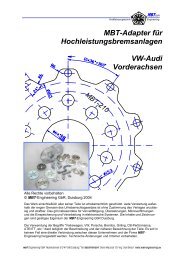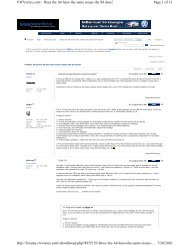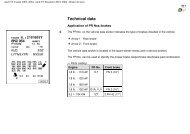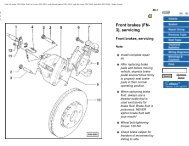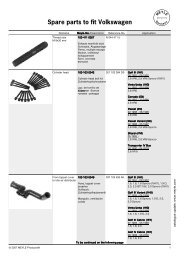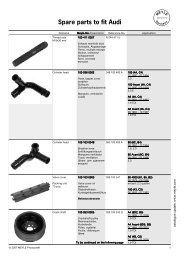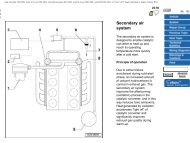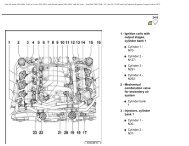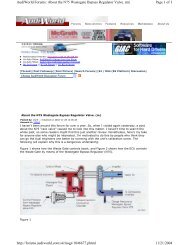VW MKII A2 MK2 Golf Jetta Fox Service Manual - VAGLinks.com
VW MKII A2 MK2 Golf Jetta Fox Service Manual - VAGLinks.com
VW MKII A2 MK2 Golf Jetta Fox Service Manual - VAGLinks.com
You also want an ePaper? Increase the reach of your titles
YUMPU automatically turns print PDFs into web optimized ePapers that Google loves.
4B•6 Fuel and exhaust systems - K-Jetronic fuel injection - 8 valve engines<br />
9.3 Cold start valve test lamp connections 10.3 Auxiliary air valve (arrowed) 11.2 Warm-up valve<br />
9 Cold start valve and<br />
thermotime switch - testing 2<br />
Cold start valve<br />
1 The thermotime switch energises the cold<br />
start valve for a short time on starting. The<br />
time for which the valve is switched on<br />
depends upon the engine temperature.<br />
2 This check must only be carried out when<br />
the coolant temperature is below 30°C.<br />
3 Pull the connector off the cold start valve<br />
and connect a test lamp across the contacts<br />
of the connector (see illustration).<br />
4 Pull the high tension lead off the centre of<br />
the distributor and connect the lead to earth.<br />
5 Pull the connector from the thermotime<br />
switch then connect an extension lead from<br />
earth to the thermotime switch W terminal<br />
(green/white wire). The red/black wire must<br />
not be earthed.<br />
6 Operate the starter and check that the test<br />
lamp lights up. If it does not, then there is an<br />
open circuit which must be located and<br />
repaired.<br />
7 To check the cold start valve, leave the<br />
thermotime switch W terminal earthed,<br />
remove the cold start valve and re-attach its<br />
connector. Take care not to break the gasket<br />
when withdrawing the cold start valve from<br />
the inlet manifold.<br />
8 With fuel line and electrical connections<br />
connected to the valve, hold the valve over a<br />
glass jar and operate the starter for 10<br />
seconds. The cold start valve should produce<br />
an even cone of spray during the time the<br />
thermotime switch is on.<br />
9 Wipe dry the cold start valve nozzle with a<br />
clean non-fluffy cloth, then check that the<br />
valve does not drip or its body be<strong>com</strong>e damp<br />
over a period of one minute. If proved<br />
defective, renew the valve.<br />
Thermotime switch<br />
10 To check the thermotime switch, proceed<br />
as described in paragraphs 3 and 4 inclusive.<br />
The coolant should be at 30°C. If the switch<br />
needs to be cooled down to the temperature<br />
specified, remove it and immerse its base in<br />
cold water. When cooled, earth the switch to<br />
make the test.<br />
11 Operate the starter for 10 seconds. The<br />
test lamp should light immediately and stay<br />
on for three seconds.<br />
12 Refit the high tension lead onto the<br />
distributor and reconnect the lead to the cold<br />
start valve.<br />
10 Auxiliary air valve - testing<br />
2<br />
1 To carry out this test, the engine coolant<br />
temperature must be below 30°C.<br />
2 Detach the distributor HT lead.<br />
3 Detach the auxiliary air valve electrical plug<br />
and ensure that the contacts in the plug<br />
connector are in good condition (see<br />
illustration).<br />
4 Connect up a voltmeter across the contacts<br />
of the plug connectors, start the engine and<br />
run at idle speed. The voltage reading must be<br />
a minimum of 11.6 V. If a voltmeter is not<br />
available, a test lamp will suffice to check the<br />
voltage supply.<br />
5 With the auxiliary air valve electrical plug<br />
still detached, leave the engine running at idle<br />
speed and pinch the air inlet duct-to-auxiliary<br />
valve hose. The engine speed should drop.<br />
11.4 Warm-up valve heater coil resistance<br />
test<br />
1081 <strong>VW</strong> <strong>Golf</strong> & <strong>Jetta</strong><br />
6 When the engine is warmed up to normal<br />
operating temperature, reconnect the auxiliary<br />
valve plug then pinch the hose again. This time<br />
the engine speed should remain unaltered.<br />
11 Warm-up valve - testing<br />
2<br />
1 Detach the distributor HT lead and earth it.<br />
2 With the engine cold, detach the wiring<br />
connector from the warm-up valve (see<br />
illustration).<br />
3 Connect a voltmeter across the terminals of<br />
the warm-up valve connector and operate the<br />
starter. The voltage across the terminals<br />
should be a minimum of 11.5 volts.<br />
4 Switch the ignition off and connect an<br />
ohmmeter across the terminals of the<br />
warm-up valve (see illustration). If the meter<br />
does not indicate a resistance of about 20 to<br />
26 ohm, the heater coil is defective and a new<br />
valve must be fitted.<br />
12 Cold acceleration<br />
enrichment system - testing 2<br />
1 When the engine is cold (below 35°C),<br />
acceleration is improved by briefly enriching<br />
the fuel mixture for a period of approximately<br />
0.4 seconds. This cold acceleration<br />
enrichment will only operate if the thermotime<br />
switch, the diaphragm pressure switch and<br />
the throttle valve switch are shut off.<br />
2 To check the system, first check that the<br />
cold start valve is operational.<br />
3 Detach the wiring connector from the cold<br />
start valve and connect up a test lamp to its<br />
terminals.<br />
4 Detach the wiring connector from the<br />
thermotime switch and connect a length of<br />
wire between an earth point and the<br />
connector No.2 terminal W (green/white wire).<br />
Do not earth terminal G (red/black wire).<br />
5 Run the engine and allow it to idle, at which<br />
point the test lamp should not light up. When<br />
the engine is quickly accelerated, the test<br />
lamp should light up briefly (0.4 seconds) (see<br />
illustration).



